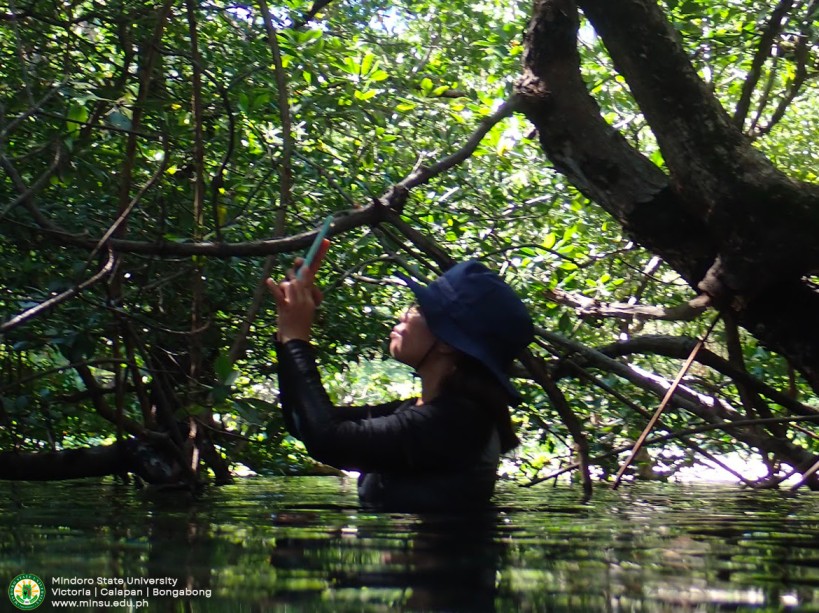
Mindoro State University (MinSU), Center for Environmental Studies (CES) in collaboration with Wetlands International, a global non-profit organization dedicated to the conservation and restoration of wetlands, conducted validation of mangrove sites across Mindoro Island. This initiative supports the BakaJuan Project, spearheaded by the Department of Environment and Natural Resources (DENR) and the Philippine Space Agency (PhilSA). The BakaJuan Project seeks to map and monitor the nation’s mangrove cover, while also encouraging volunteer participation in mangrove conservation efforts.
The validation took place for 12 days, from June 15 to 30, 2024. Utilizing modern technology, including ODK (Open Data Kit) applications and drones, the team successfully validated 27 mangrove sites. The research team was comprised of four (4) mangrove taxonomists, two (2) ODK operators, and a drone mapping specialist.
Detailed Findings Across the Island were as follows:
Calapan City (Palhi and Nag-iba)
The Nag-iba site revealed a mix of planted and natural mangroves, with abundant Sonneratia species and scattered nipa palms along riverbanks. Palhi’s site, in contrast, had minimal mangroves interspersed among nipa and coconut trees.
Naujan and Pola (San Jose and Pula)
These areas featured mangroves primarily located in old fish ponds, extending along rivers and highways, illustrating a landscape shaped by both natural and human activity.
Pinamalayan (Lumangbayan and Papandayan)
Lumangbayan’s mangroves were a mix of natural and planted species along rivers, while Papandayan had mangroves growing near community roads, houses, and waterways.
Bulalacao (Buyayao Island and Balatasan)
The mangroves on Buyayao Island thrived along the coast, whereas Balatasan was characterized by a dense presence of the Heritiera littoralis species, which is locally abundant.
Occidental Mindoro (San Nicholas, Magsaysay, and Salvacion)
These sites revealed a mix of natural and planted mangroves thriving in old fishponds, with extensive nipa growth along rivers.
San Jose (Mangarin and Mapaya)
The Mangarin and Mapaya sites featured mostly planted mangroves near San Jose Fish Port and salt farms, highlighting Rhizophora and Sonneratia species as dominant.
Ilin Island (Ansiray)
Ansiray was notable for its dense mangrove plantation of Rhizophora species, recognized as the widest mangrove area in Occidental Mindoro.
Sta. Cruz and Mamburao (Poblacion and Payompon)
These areas were dominated by nipa mangroves, aged and densely thriving in the central regions.
Paluan (Harrison)
The Harrison site presented a smaller mangrove area with sparse distribution around coastal fish ponds, where Acanthus ilicifolius was prevalent.
Sablayan (Poblacion and Ibud)
Poblacion’s mangroves, managed by Sablayan CENRO, showed a dense coastal presence, while Ibud’s were patchily distributed along rivers.
Gloria and Bongabong (Balete and Anilao)
In these areas, mangroves were naturally dense near estuaries and included both natural and planted species across fishponds and coastal zones.
Roxas and Mansalay (San Jose and B. Del Mundo)
San Jose’s mangroves mixed planted and natural types in old fishponds and coastal areas, while B. Del Mundo’s were concentrated in coastal zones.
The data collected from these validation efforts were forwarded to PhilSA for the official mapping and marking of the validated sites.
The BakaJuan Project continues to encourage volunteers and stakeholders to take part in this critical initiative to safeguard mangrove forests for ecological sustainability and coastal protection.
(Story by John Vincent Santiago)
#SDG 13 #SDG14 #SDG15 #SDG17
302 Staff
10531 Students
9 Colleges
4 Years